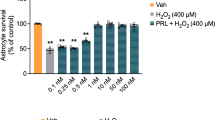Abstract
Our previous study demonstrates that SYB produces a neuroprotective effect in vivo. In the present study, we investigated the protective effect of safflor yellow B (SYB) on the acute oxidative injury induced by H2O2 and mechanisms in PC12 cells. H2O2 was used to mimic in vitro model of the oxidative injury and to induce apoptosis in PC12 cells. The cells were pretreated with the different concentrations of SYB. The cell viability, lactate dehydrogenase (LDH) release, malondialdehyde (MDA), and superoxide anion levels, superoxide dismutase (SOD) and glutathione peroxidase (GSH-Px) activities were measured. Caspase 3 activity, Bcl-2 and Bax expressions were also observed. The results showed that exposure of the cells to H2O2 significantly decreased the cell viability, SOD and GSH-Px activities and Bcl-2 expression, and increased LDH release, superoxide anion and MDA generations, caspase 3 activity and Bax expressions. Pretreatment of the cells with SYB was able to remarkably antagonize the H2O2-induced changes in dose-dependent way. These suggest that SYB is able to protect PC12 cells from H2O2-induced injury and apoptosis via antioxidant and anti-apoptotic mechanisms.






Similar content being viewed by others
References
Chan PH (2001) Reactive oxygen radicals in signalling and damage in the ischemic brain. J Cereb Blood Flow Metab 21:2–14
Cheng XR, Zhang L, Hu JJ, Sun L, Du GH (2007) Neuroprotective effects of tetramethylpyrazine on hydrogen peroxide-induced apoptosis in PC12 cells. Cell Biol Int 31:438–443
Dumont A, Hehner SP, Hofmann TG, Ueffing M, Droge W, Schmitz ML (1999) Hydrogen peroxide-induced apoptosis is CD95-independent, requires the release of mitochondria-derived reactive oxygen species and the activation of NF-kappa B. Oncogene 18:747–757
Fujita Y, Izawa Y, Ali N, Kanematsu Y, Tsuchiya K, Hamano S, Tamaki T, Yoshizumi M (2006) Pramipexole protects against H2O2-induced PC12 cell death. Naunyn Schmiedebergs Arch Pharmacol 372:257–266
Globus MY, Busto R, Lin B, Schnippering H, Ginsberg MD (1995) Detection of free radical activity during transient global ischemia and recirculation: effects of instrastriatal brain temperature modulation. J Neurochem 65:1250–1256
Halliwell B (1992) Reactive oxygen species and the central nervous system. J Neurochem 59:1609–1623
Heistad DD (2006) Oxidative stress and vascular disease: 2005 Duff lecture. Arterioscler Thromb Vasc Biol 26:689–695
Imai H, Masayasu H, Dewar D, Graham DI, Macrae IM (2001) Ebselen protects both gray and white matter in a rodent model of focal cerebral ischemia. Stroke 32:2149–2154
Jang JH, Surh YJ (2004) Bcl-2 attenuation of oxidative cell death is associated with up-regulation of gamma-glutamylcysteine ligase via constitutive NF-kappa B activation. J Biol Chem 279:38779–38786
Kim TS, Yun BY, Kim IY (2003) Induction of the mitochondrial permeability transition by selenium compounds mediated by oxidation of the protein thiol groups and generation of the superoxide. Biochem Pharmacol 66:2301–2311
Kim HJ, Lee KW, Kim MS, Lee HJ (2008) Piceatannol attenuates hydrogen-peroxide- and peroxynitrite-induced apoptosis of PC12 cells by blocking down-regulation of bcl-X (L) and activation of JNK. J Nutr Biochem 19:459–466
Kuroda S, Siesjo BK (1997) Reperfusion damage following focal ischemia: pathophysiology and therapeutic windows. Clin Neurosci 4:199–212
Li XJ, Zhang LM, Gu J, Zhang AZ, Sun FY (1997) Melatonin decreases production of hydroxyl radical during cerebral ischemia–reperfusion. Acta Pharmacol Sin 18:394–396
Matsumiya N, Koehler RC, Kirsch JR, Traystman RJ (1991) Conjugated superoxide dismutase reduces extent of caudate injury after transient focal ischemia in cats. Stroke 22:1193–1200
Piantadosi CA, Zhang J (1996) Mitochondrial generation of reactive oxygen species after brain ischemia in the rat. Stroke 27:327–331
Saito Y, Nishio K, Ogawa Y, Kinumi T, Yoshida Y, Masuo Y, Niki E (2007) Molecular mechanisms of 6-hydroxydopamine-induced cytotoxicity in PC12 cells: involvement of hydrogen peroxide-dependent and -independent action. Free Radic Biol Med 42:675–685
Ste-Marie L, Vachon P, Vachon L, Bémeur C, Guertin MC, Montgomery J (2000) Hydroxyl radical production in the cortex and striatum in a rat model of focal cerebral ischemia. Can J Neurol Sci 27:152–159
Wang C, Zhang D, Li G, Liu J, Tian J, Fu F, Liu K (2007) Neuroprotective effects of safflor yellow B on brain ischemic injury. Exp Brain Res 177:533–539
Wu Y, Shang Y, Sun SG, Liu RG, Yang WQ (2007) Protective effect of erythropoietin against 1-methyl-4-phenylpyridinium-induced neurodegeneration in PC12 cells. Neurosci Bull 23:156–164
Yamamoto T, Yuki S, Watanabe T, Mitsuka M, Saito KI, Kogure K (1997) Delayed neuronal death prevented by inhibition of increased hydroxyl radical formation in a transient cerebral ischemia. Brain Res 762:240–242
Yu ZF, Bruce-Keller AJ, Goodman Y, Mattson MP (1998) Uric acid protects neurons against excitotoxic and metabolic insults in cell culture, and against focal ischemic brain injury in vivo. J Neurosci Res 53:613–625
Zhang SQ, Jiang LD (2004) Effect of safflower injection on cardiac energy charge and anti-apoptosis gene bcl-2 in rat heart. Chin J Integr Tradit West Med 24:442–444
Zhao Q, Pahlmark K, Smith ML, Siesjö BK (1994) Delayed treatment with the spin trap a-phenyl-N-tert-butyl nitrone (PBN) reduces infarct size following transient middle cerebral artery occlusion in rats. Acta Physiol Scand 152:349–350
Author information
Authors and Affiliations
Corresponding authors
Rights and permissions
About this article
Cite this article
Wang, C., Ma, H., Zhang, S. et al. Safflor yellow B suppresses pheochromocytoma cell (PC12) injury induced by oxidative stress via antioxidant systemand Bcl-2 /Bax pathway. Naunyn-Schmied Arch Pharmacol 380, 135–142 (2009). https://doi.org/10.1007/s00210-009-0424-x
Received:
Accepted:
Published:
Issue Date:
DOI: https://doi.org/10.1007/s00210-009-0424-x




